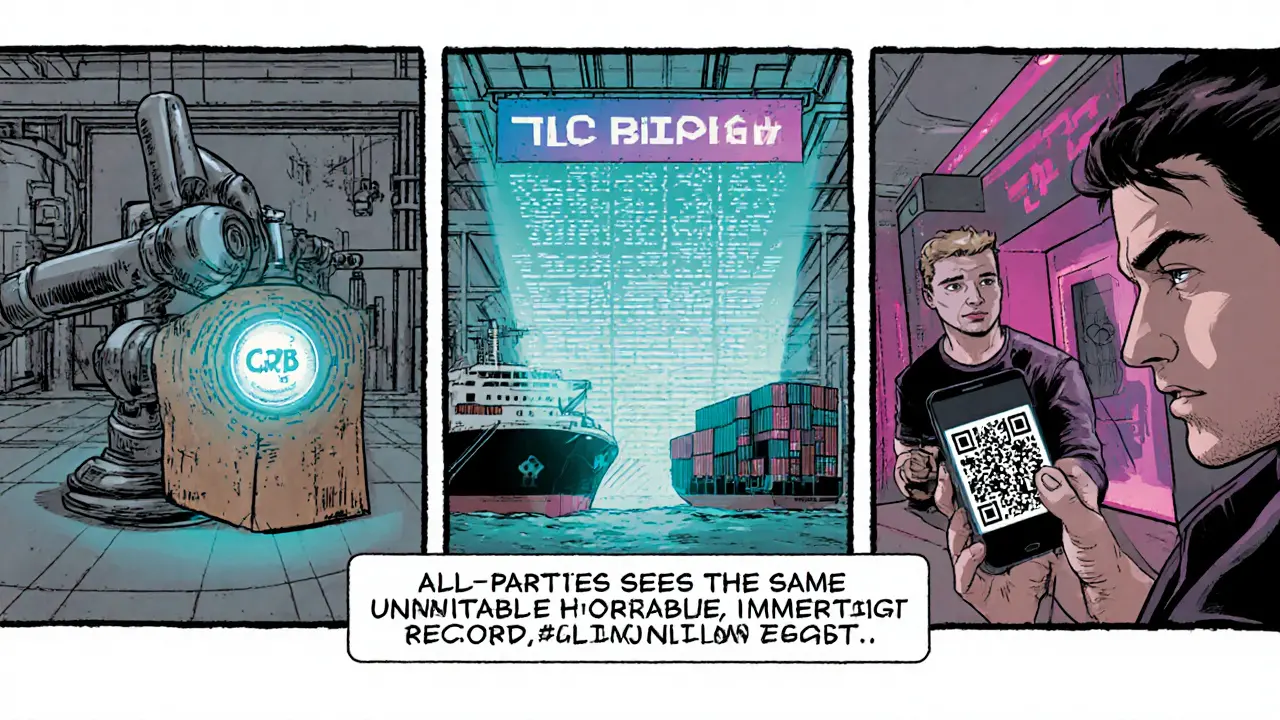Blockchain Immutability Benefits Calculator
Benefits Analysis Results
Data Integrity
With immutable records, your data remains unchanged forever. Even if a hacker gains access to one node, they cannot alter the data without detection.
Original Data → 8b73b3a1c2d4e5f6...
Trust & Transparency
All parties see the same data. No need for lengthy verification processes or legal agreements to establish trust.
Block N-1 → Block N → Block N+1
Audit Efficiency
Audits become significantly faster and cheaper. Traditional audits take weeks; blockchain audits take hours.
70% faster auditing
Fraud Prevention
Duplicate records and altered data are instantly flagged. Fraudsters cannot manipulate the system without detection.
Hash Mismatch = Fraud Detected
Financial Impact Summary
Annual Potential Savings: $0
Compliance Cost Reduction: 0%
Audit Time Reduction: 0%
How Blockchain Immutability Works
Each block in a blockchain contains a cryptographic hash of the previous block, creating an unbreakable chain. If someone tries to change data in a past block, the hash changes, breaking the chain and alerting all network participants.
Block 1 → Hash(A) → Block 2 → Hash(B) → Block 3
When you hear the phrase immutable blockchain records are permanent, tamper‑proof entries stored on a distributed ledger, the first thought is usually security. But the upside goes far beyond keeping hackers out. In this guide we’ll walk through the concrete advantages-data integrity, trust, auditability, and more-while showing how the underlying tech (hashing, consensus, Merkle trees) makes those benefits possible.
How Immutability Is Built In
At the heart of every blockchain is a cryptographic fingerprint that guarantees a block can never be altered without alerting the whole network. This fingerprint is created by cryptographic hashing a process that turns any input into a fixed‑length, unique string, most commonly using the SHA‑256 algorithm.
Each block contains:
- The data payload (transactions, records, etc.).
- A Merkle tree a hierarchical hash structure that lets anyone verify a single record without scanning the whole block root.
- The previous block’s hash, linking the chain together.
Because every new block references the hash of its predecessor, changing even a single byte in an old block would cascade into a completely different hash value for that block and all following blocks. The network would instantly reject the tampered chain.
Consensus Mechanisms: The Guardrails
Immutability isn’t magic; it’s enforced by consensus mechanisms rules that require a majority of nodes to agree on new data before it’s added. Two dominant models illustrate the trade‑offs:
| Attribute | Proof of Work (PoW) | Proof of Stake (PoS) |
|---|---|---|
| Energy consumption | High (mining hardware) | Low (validator stake) |
| Security model | Hash‑power majority required to attack | Stake majority required to attack |
| Finality speed | Minutes to hours | Seconds to minutes |
| Scalability | Limited by block time | Better throughput potential |
Both mechanisms make it practically impossible to rewrite history without controlling a majority of the network, which is the core reason why records stay immutable.
Data Integrity and Security Benefits
Because every entry is sealed by cryptographic hashes and validated by consensus, the data you write once stays exactly the same forever. This gives three tangible security wins:
- Fraud resistance: Financial institutions can lock transaction logs in a way that auditors can’t dispute.
- Attack mitigation: A hacker would need to compromise >50% of nodes to rewrite history-an unrealistic feat for well‑distributed networks.
- Replay protection: Duplicate or altered records are instantly flagged as mismatched hashes.
Industries that demand airtight records-finance, healthcare, legal-rely on this guarantee to meet strict regulatory standards.
Trust and Transparency Across Parties
When every participant can view the same, unchangeable ledger, trust becomes a by‑product of the technology, not a costly legal agreement. Consider a supply‑chain scenario:
- Manufacturer records the origin of raw material on a blockchain.
- Distributor adds a timestamped hand‑off event.
- Retailer queries the chain and sees a full, immutable history without contacting each previous party.
Because the data is transparent visible to all authorized participants in real time, any attempt to claim a counterfeit product can be disproved instantly.

Auditing and Compliance Made Easy
Traditional audits involve pulling paper trails, reconciling spreadsheets, and spending weeks verifying signatures. With immutable blockchain records, auditors simply read the ledger and compare it to the organization’s reports. The result is:
- Reduced audit time by up to 70% (according to a 2023 Deloitte survey).
- Lower compliance costs because regulators accept blockchain logs as “definitive evidence”.
- Immediate dispute resolution-there’s no “he‑said‑she‑said” when the chain itself tells the story.
Real‑World Use Cases
Below are three sectors that have already deployed immutable records at scale:
- Healthcare patient records, consent logs, and drug provenance stored on permissioned blockchains, preventing accidental alteration that could jeopardize treatment.
- Financial services settlement of trades and cross‑border payments logged immutably to curb fraud and meet AML/KYC rules.
- Supply chain management tracking of goods from factory to shelf, ensuring authenticity and reducing counterfeits.
Implementation Challenges You Should Know
Nothing is perfect. Deploying immutable records comes with hurdles:
- Technical complexity: Setting up a distributed ledger requires specialized skills-many firms hire blockchain consultants or use platform‑as‑a‑service solutions.
- Governance rigidity: Once data is written, you can’t delete it. If you need to correct a mistake, you must add a new corrective entry rather than edit the original.
- Performance limits: Transaction throughput is lower than centralized databases, and latency can be an issue for high‑frequency use cases.
- Scalability: As the chain grows, each node must store the full history, increasing storage costs.
Understanding these trade‑offs helps you decide whether a public blockchain, a permissioned network, or a hybrid approach best fits your needs.
Future Outlook
Industry analysts predict the market for immutable blockchain records will grow at a CAGR of 38% through 2030, driven by tighter data‑privacy laws and the rise of AI‑enabled compliance tools. Emerging solutions-such as zero‑knowledge proofs and sharding-aim to keep the benefits of immutability while tackling scalability and privacy concerns.
In short, immutable blockchain records turn data from a vulnerable asset into a trusted, auditable resource. Whether you’re a CFO, a hospital IT director, or a logistics manager, the technology offers a clear path to stronger security, lower costs, and higher confidence in the numbers you rely on.
Frequently Asked Questions
What makes a blockchain record immutable?
Immutability comes from cryptographic hashes that link each block to the one before it and from consensus mechanisms that require the majority of nodes to approve new entries. Changing any past data would break the hash chain and be rejected by the network.
Can immutable records be deleted or edited?
No. Once data is written, it stays forever. If a mistake occurs, you add a new corrective transaction that references the original entry, preserving an audit trail of both the error and the fix.
Which consensus mechanism is best for high‑speed applications?
Proof of Stake generally offers faster finality and lower energy use than Proof of Work, making it more suited for applications that need quick confirmation times.
How does immutability help with regulatory compliance?
Regulators can inspect the blockchain directly as a tamper‑proof source of truth. This eliminates the need for manual reconciliations and reduces the risk of falsified reports.
What are the main costs of implementing immutable blockchain records?
Costs include infrastructure (node hardware or cloud services), developer expertise, and potential scaling solutions like sidechains or Layer‑2 protocols to keep performance acceptable.



Shamalama Dee
April 5 2025Immutable records aren’t just a buzz‑word; they give us a solid foundation for trust across departments. When a transaction is written once, you know it can’t be altered later, which cuts down on endless reconciliation work. Think of it as a digital ledger that remembers every entry forever, letting auditors sleep easier.
scott bell
April 7 2025Picture this: a single block of data locked in stone, echoing through the network like a thunderstorm that never stops
the ripple effect is instant and unstoppable
vincent gaytano
April 8 2025Oh sure, because we all love trusting a system that pretends to be infallible-just hand over your secrets and watch the magic happen
Dyeshanae Navarro
April 10 2025If you can’t change a record, you can’t cheat the system. That’s why banks love it, and why regulators feel safer.
Matt Potter
April 11 2025Stop overthinking it-immutability works!
Marli Ramos
April 13 2025lol immutability sounds fancy 😒 but real life still has bugs.
Christina Lombardi-Somaschini
April 14 2025It is worth noting, with the utmost respect, that the cryptographic hash functions, such as SHA‑256, provide a deterministic yet collision‑resistant fingerprint; consequently, any attempt to modify a prior block would inevitably result in a hash mismatch, thereby alerting the entire network to the inconsistency.
katie sears
April 16 2025From a governance perspective, an immutable ledger serves as a single source of truth, reducing the need for redundant cross‑checking mechanisms, and consequently streamlining inter‑organizational collaborations across borders.
Gaurav Joshi
April 17 2025We must remember that integrity is not optional; a tamper‑proof ledger forces us to act honestly, lest we face collective censure.
Kathryn Moore
April 19 2025Immutable = trust, transparency, efficiency.
Christine Wray
April 20 2025While immutability brings clear benefits, we should still weigh the cost of storage and the challenges of data correction mechanisms.
roshan nair
April 22 2025Let’s break this down: imagine a chain where every link is painted with a unique color-if you try to replace a link, the whole rainbow shifts, and the network instantly knows something’s off. That visual metaphor helps the develpers grasp why consensus matters. It also shows how quickly a corrupted block would be spotted, preventing malicious tampering.
Jay K
April 23 2025Your analogy captures the essence perfectly; the visual cue of a shifting spectrum makes the abstract concept much more approachable for newcomers.
Kimberly M
April 25 2025Exactly, and that clarity is what drives wider adoption across sectors, from finance to healthcare 🙂.
Navneet kaur
April 26 2025It’s simple: if you can’t erase a mistake, you’ll think twice before making one, which is the whole point of a trustworthy systme.
Marketta Hawkins
April 28 2025Our country’s tech leaders should champion blockchain immutability to keep our data sovereign and free from foreign meddling.
Drizzy Drake
April 29 2025When you look at the broader picture, immutable blockchain records act as the backbone of a trustworthy digital economy.
They eliminate the endless back‑and‑forth that accountants spend chasing paper trails.
By guaranteeing that once a transaction is recorded it cannot be altered, businesses can focus on innovation rather than reconciliation.
Regulators appreciate the transparent audit trail, which reduces the manpower needed for inspections.
Customers gain confidence because they can verify the history of a product or a service on their own.
Supply‑chain managers can trace the origin of goods in real time, spotting counterfeits before they reach the shelf.
Healthcare providers can lock patient consent records, ensuring that no accidental edits compromise treatment plans.
Financial institutions can prevent double‑spending attacks, safeguarding billions in assets.
Legal contracts encoded on a blockchain become self‑executing, cutting down on costly litigation.
Moreover, the decentralised nature of the network means no single entity can censor or rewrite history.
Even if a malicious actor compromises a node, they would need to control the majority to change anything, which is practically impossible.
This security model also deters insider threats, as employees cannot stealthily modify records without detection.
From an operational standpoint, automated smart‑contracts reduce manual processing time dramatically.
Companies reporting on ESG metrics can use immutable ledgers to prove sustainability claims to investors.
While the technology does introduce storage overhead, advancements like pruning and layer‑2 solutions mitigate those concerns.
In summary, the blend of security, transparency, and efficiency makes immutable records a strategic asset for any forward‑thinking organization.
AJAY KUMAR
May 1 2025Imagine a future where every lie is instantly exposed-immutability makes that drama a reality!
bob newman
May 2 2025Sure, because the only thing stopping governments from rewriting history is a handful of nodes they can’t bribe.
Anil Paudyal
May 4 2025Bottom line: immutable ledgers cut audit time, period.
Kimberly Gilliam
May 5 2025Immutability = game changer